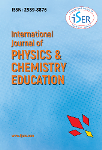Investigating First Year University Physics Students’ Ability to Integrate Algebraic and Kinematics Graphs
Keywords:
Interpretations, Kinematics, Equations and graphs, Mathematical skills, Conceptual knowledge, Introductory physicsAbstract
An important tool in the teaching and learning or study of physics is regarded as Mathematics, i.e., it will not be easy to study Physics without the basic knowledge and skills in Mathematics. Mathematics as a “language of science”, and is an expected requirement for students to study physics (Redish, 2005). He furthers argues that physicists blend conceptual physics with mathematical skills and use them to solve and interpret equations and graphs. For instance, in kinematics, different aspects from mathematics such as knowledge of functions and the solving of equations are combined with physics concepts. Many introductory physics students perform poorly on the use of mathematical skills and interpretations of graphs in physics. Two possible reasons may be as follows: i. Students lack the necessary mathematical skills needed to solve the physics problems. ii. Students do not know how to apply and relate their mathematical skills in the context of physics. These two possible reasons were investigated in a Masters Research project which probed first year university students’ interpretations of graphs in kinematics and in mathematics. This paper used the idea of Beichner’s standardized questionnaire on kinematic graphs. From this questionnaire, an equivalent questionnaire was devised in the context of Mathematical equations and graphs. The results of the investigation tend to indicate the deficiencies in the students’ mathematical conceptual knowledge as well as in the transfer of mathematical skills that they possess to solve kinematic equations and graphs. New teaching approaches in the introductory physics, a pre-requite for all STEM studies were thus recommended to enhance student performance in this subject.
Downloads
References
Basson, I. (2002). Physics and Mathematics as interrelated fields of thought development using acceleration as an example. International Journal of Mathematical Education in Science and Technology, 33(5), 679 – 690.
Beichner, R.J. (1993). Testing student interpretation of kinematics graphs. American Journal of Physics, 62(8), 750 – 762
Beichner, R.J. (2011). Test of understanding Graphs of Kinematics, version 2.6. PhyPort: Supporting physics teaching with research based resource, 2011.
Chambers, J., Cleveland, W., Kleiner, B., and Tukey, P. (1983). Graphical Methods for Data Analysis, Wadsworth International Group
Bing, T. J., & Redish, E. F. (2007). The cognitive blending of mathematics and physics knowledge. In 2006 Physics Education Research Conference, 883, 26-29.
Eshach, H. 2010. Re-examining the power of video motion analysis to promote the reading and creating of kinematic graphs. Asia-pacific forum on science learning and teaching, 11(2, Article 8).
Maimane, J.R. (2006). Motivating primary school learners in mathematics classroom. Acta Academia 2006, 38 (2), 243 - 261
Redish, E.F. (2005) Problem solving and the use of mathematics in physics courses. Proceedings of the Conference, World View on Physics Education in 2005: Focusing on Change.
Redish, E. F., & Gupta, A. (2010). Making Meaning with Math in Physics: A semantic analysis. arXiv preprint arXiv:1002.0472.
Redish, E. F., & Hammer, D. (2009). Reinventing college physics for biologists: Explicating an epistemological curriculum. American Journal of Physics, 77(7), 629-642.
Roth, W. M. (1993). Problem‐Centered Learning for the Integration of Mathematics and Science in a Constructivist Laboratory: A Case Study. School Science and Mathematics, 93(3), 113-122.
Van Tonder, A., 2010. Difficulties in the comprehension and interpretation of a selection of graph types and subject-specific graphs displayed by senior undergraduate biochemistry students in a South African university. (PhD Thesis – Unisa). Retrieved from http://hdl.handle.net/10500/4913. Date of access: 20 Nov. 2015.
Downloads
Published
How to Cite
Issue
Section
License
Copyright (c) 2018 Authors, IJPCE

This work is licensed under a Creative Commons Attribution-NonCommercial 4.0 International License.
Copyright © Authors


